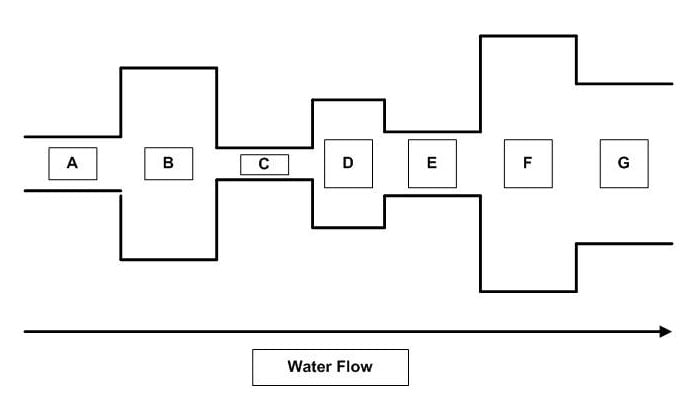Destroy “Small business disease”
I’d like to talk to you today about an insidious problem that afflicts most self employed and entrepreneurial people. I call it “small business disease”. Let’s say you start a business, and you end up with a working business model. You have a repeatable marketing and production process, and people are buying what you have to offer. That’s great, but now what? If you thought you were working hard before you had customers, oh boy look out now! With every order, you have more work to do. Every success adds to the stress. Before long, you just don’t try as hard to grow the business because every new customer is just a new burden. Sound familiar?
IOFlood has given me a great opportunity to improve my business and managerial skills. Maybe “opportunity” is not how you’d normally think of it, as it was more of a “sink or swim” kind of thing. I find that I work best under pressure, and the best time to learn a new skill is when you really have to. Most of the skills I really value, I learned not because I wanted to, but because they were necessary to achieve a meaningful goal. Learning how to escape small business disease has been no different.
When IOFlood really started to take off, there was no way around it. I needed to learn to manage a team of people, delegate work effectively, and find a way to ensure consistency without being involved in every bit of work. The only alternative was to be doomed to working harder and harder for less and less result. The journey never ends, but I’m proud to say we’re well on our way, and I’d like to share with you what I’ve learned so far.
Focus means saying no.
If you’ve gotten this far with your business, you’re probably really good at spotting things that can be improved. New opportunities in the market, niches that can be filled, inefficiencies made efficient. Unfortunately, this can easily become overwhelming, as the list of possible improvements you could make could never be completed in a lifetime. To ever get things done, you need to focus. And focus means saying no to a vast number of perfectly reasonable ideas and opportunities. But you still need to do something, so what do you say “yes” to?
Say yes to leverage
By “leverage”, I mean, whatever activity will produce the most result for the least effort. Sounds obvious, right? It may be obvious, but like common sense, it is rarely practiced. With so many good ideas and areas for improvement, how can you possibly know which one gives you more leverage than the others? I have good news, it’s actually a pretty simple 3 step process:
Step 1: Identify the “value chain”.
This would be the set of repeatable steps that ends with money in your pocket. If you manufactured toys, it would start with an order for toys (and the work needed to solicit that order), and end with toys delivered to and paid for by your customer. In server hosting, it starts with the marketing and sales activities required to gain an order, continues through the provisioning and setup process (including any steps like fraud checking, order validation, OS installation, etc), and ends once the customer has received something that meets their satisfaction.
Identifying the value chain is important, because increasing the flow of activity through this chain of steps will increase both your top and bottom lines; nothing else will. Many other things may be required to stay in business, (book keeping, taxes, customer support), but increasing the value chain is what makes you more money.
Step 2: Identify the bottleneck.
Once you have an idea for the steps that make up the value chain, you can start trying to improve those steps. But before you do, you need to focus. You need to see which improvements will actually make things better. To do this, you need to identify the bottleneck. Much like a physical bottleneck, there is always one portion of a process that holds back the flow of material through your value chain. Improving or worsening anything else makes little or no difference. See the following visual:
In the above image, I’m sure you’d have no problem figuring out what is holding back water flow in this pipe system. What would be the effect of making pipe segment “B” larger? How about “D”? What would happne if “F” was about half as large? If you said “nothing” you’d be right. The only thing that can increase the flow of water through this pipe system is increasing the size of pipe “C”. Until “C” is at least as large as the next smallest pipe segment, everything else is a total waste of time. This is why we need to find the bottleneck. But how?
A bottleneck can be either a process, a step in a process, a person, a piece of equipment, or a department. Either way, the bottleneck is whatever resource is holding up the total flow of work through the system. Luckily, finding the bottleneck is pretty simple, once you know what is in your value chain (and what is not). Look for where the work piles up. In a manufacturing plant, this would be taken literally: in front of what machine or person does the work literally “pile up”? In a service based business, it might be less visually obvious, but I’m sure you can still figure it out.
When a task needs to be done before something else can happen, which task is least likely to get done in a timely manner? This is probably your bottleneck. If you’re not sure, it can be helpful to try to make your work-in-process visible. We have a system where each step in a server setup is given a support department, and tickets move through each department on their way to completion. If a lot of tickets tend to pile up in one department, and not in others, it’s a fair bet that’s where our bottleneck is.
Step 3: Increase the productivity of the bottleneck.
You may be thinking this is the hardest part of the process, but really, it’s not. The hardest part is making the emotional commitment to improving the productivity of the bottleneck. It’s hard to give up unimportant work, because it’s comfortable, or other people expect you to do it. Saying yes to the important means saying no to a lot of things other people expect you to do.
Once you’ve identified what is holding back the performance of your company, you have no excuses. You either have to fix the real problem (now that you know what it is), or you have to admit that you really don’t want to improve your business. If you thought failure was hard normally, imagine the difficulty of failing when you have no excuses to fall back on. The willingness to identify the real problems in your business requires great emotional strength.
Being willing to even see the problem for what it is, let alone to commit to fixing it, is really hard. Chances are that you already would have fixed this problem if it were easy to do. Chances are that what you need to do to fix the problem is outside your comfort zone. You may need to learn new skills. The good news is, you’re smart. Once you commit, you’ll be able to figure the rest out. Are you willing to do what it takes to improve your business? If you are, here are some tips that may help you:
1. Don’t waste the bottleneck resource. Work should be checked before it gets to the bottleneck, so it doesn’t waste time redoing defective work. Steps and people immediately prior to the bottleneck resource should build a “buffer” of work so that the bottleneck always has something productive to do.
2. It’s ok to “waste” the non-bottleneck resources, if it makes the bottleneck more productive.
3. Delegate away from the bottleneck resource. What does the bottleneck do that someone else can do? Even if the bottleneck does it faster or better, it doesn’t matter, someone else should do it if at all possible.
4. Get more of the bottleneck. Eventually you’ll just need more total capacity, there’s no way around it. Improve your training, processes, and procedures so that other people can perform the work the bottleneck is performing. Or get more people who can do the same work the bottleneck can do.
If you can remove half the work from the bottleneck, you can double the productivity of the entire system. For a company with 10 employees where 1 is a bottleneck, this means that shifting around one half of one employee’s workload to the other 9 people can double the productivity of all 10 people. That’s what I call leverage.
What if you’re the bottleneck?
Chances are, if you have small business disease, you’re probably the bottleneck. And you’ve got all sorts of good reasons to stay that way. “Nobody does it like I do it”. “I tried giving the work to other people but they always screw it up”. “Nothing gets done if I don’t do it myself”. I have good news and bad news for you. The bad news is, all of these problems are your fault. The good news is, all of these problems are your fault, because that means you can fix them.
If you’re a small business owner, you’re probably a self motivated person. You see problems, you fix them. You see opportunities, you take advantage of them. You take risks. You enjoy learning, and deal well with ambiguity. Then you hire people. Employees. People who are not like you. If they were like you, why would they work for you instead of starting their own business? Because you’ve been so absorbed with the work of your business, you are probably really great at whatever it is that you’re doing, and not so great at working with and understanding people who are Not… Like… You. I have really bad news: If you want to escape small business disease, this has to change. The good news: you can learn it and do it a little at a time.
Management through checklists
The things you think of as “one step” really have dozens or hundreds of implied steps within them. You’re an expert, so you can mostly keep these steps in your head, doing a complex set of tasks as though it were turning a key. If you ever want non-experts to take some load off of you, a different perspective is required. You need a way for a non expert to remember to do all of the things that need doing. You need a way for you to remember all of the things you need to train someone on if you want them to take over the tasks you are responsible for. If you run your own business, and you’re new to managing people, and you need to get results right now, there’s nothing I can recommend more than checklists.
Let’s make it simple.
1. Start with the bottleneck. What is the simplest, easiest to train for task, that the bottleneck is currently responsible for? Let’s start with that.
2. Start with the instructions someone at *your level* of skill would need in order to perform the task. Your checklist should indicate “what” to do, not “how” to do it.
3. Work through the checklist yourself. Doing only what the checklist told you to do, could you successfully complete the work? If not, improve the checklist accordingly to take into account tasks you forgot about and unexpected edge cases
4. Try to train someone else on the checklist. Is most of it self explanatory? What parts need more explanation? Write a separate “training document” for the “how to do” parts of the steps. Improve the checklist so that the “what to do” makes sense given the feedback you get from the person you are training.
5. Include “outs” to the process, where tricky situations are escalated to someone with more experience or authority. Remember, the idea is not that the person you delegate to will handle every possible situation. The idea is to relieve the bottleneck of workload. The fastest way to do that is to focus on the most common situations, not to try to deal with all of them.
6. After these improvements, is the person you trained able to adequately perform the task in most cases? If so, congratulations, you’ve begun the transition away from worker and towards manager.
It’s also a good idea to give each employee a “daily checklist”, which indicates the other forms and checklists they’re expected to complete throughout the day. That way your employees know what is expected of them without you having to remind them every day.
You can continue to make more processes and more checklists, focusing on high value tasks, tasks that occur frequently or are particularly time consuming, or focusing on tasks that are simply easy to delegate. Regardless of how you select them, you should be focusing on tasks that are currently performed by the bottleneck. Don’t waste your time fixing things that aren’t broken.
——————-
I know this blog post was pretty long, but I hope you found it worthwhile. Variations on the above strategies have allowed us tremendous growth at IOFLOOD, breaking through one bottleneck after another in ways I didn’t believe was possible, while also leading to great personal growth in both skills and experience.
If you’re interested in learning more about delegation through processes and checklists, I would recommend reading The E-Myth Revisited: Why Most Small Businesses Don’t Work and What to Do About It http://www.amazon.com/The-E-Myth-Revisited-Small-Businesses/dp/0887307280
If you’re interested in learning more about bottlenecks, then there are an entire series of books on “the theory of constraints”, which has been incredibly helpful in focusing my efforts where they will do the most good. Two excellent ones are listed below:
If you’re in the IT industry, by far the best Theory of Constraints book that you can read would be The Phoenix Project: A Novel about IT, DevOps, and Helping Your Business Win http://www.amazon.com/The-Phoenix-Project-Helping-Business/dp/0988262592
Of course, the classic book The Goal: A Process of Ongoing Improvement http://www.amazon.com/The-Goal-Process-Ongoing-Improvement/dp/0884271951 is required reading for most MBA programs for very good reason.
The lessons learned in The Goal, The Phoenix Project, and The E-Myth, if taken to heart, are more valuable than I can put into words. The ideas in this blog post, and the more detailed versions of these ideas in the books listed above, make it possible to escape small business disease, growing your business without driving yourself crazy.
Now get back to work! : )



